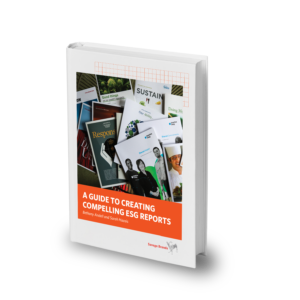Sustainability Reports In Today’s World: Core Things To Consider
In the world of sustainability, data is king. Environmental, Social and Governance (ESG) reporting is highly complex and finding ways to make it simple and easy to understand is imperative when a range of stakeholders with varying levels of comprehension about your industry are looking at you.
It is critical to self-measure and share your efforts in a Sustainability Report (SR) so that these stakeholders don’t make assumptions or draw their own conclusions about your results. Developing an SR is not for the faint of heart. There is a massive amount of information that needs to be conveyed. How this information gets articulated and visualized is critical to avoiding it getting buried or misunderstood. The numbers and your story must be told in a way that is easily digestible.
Whether your company is embarking on its first sustainability report or looking to scale up reporting efforts, we would like to share some of the best practices in the design of Sustainability Reports.
Data Visualization
Unless you’re speaking to engineers or accountants, most people will skip number-intense content and skim your report looking for general topline or key points. Finding compelling ways to visualize your data can improve readability, demystify ESG activities and clarify your impact. To simplify your data, use well-designed charts, graphs, diagrams or pictures that provide both a quick snapshot and more details for those looking to drill deeper. This enables you to tell the story of what data is important, and what is important about the data.
Infographics
Infographics are graphic, visual representations intended to present information quickly and clearly. They are powerful ways to make complex stories simple and easy to understand, and to emphasize things you want viewers to focus on. If there is something about your ESG efforts that is misunderstood or difficult to understand by those outside your industry, use infographics instead of words to explain. Simplifying complex systems, processes, activities, etc. through this type of consolidated visualization will show instead of tell, keeping your audience engaged and in control of how they consume content most interesting to them.
Digital Report Interactivity
While some companies still print their sustainability reports (a contradiction in sustainability practices we must say), more and more are moving to an online presence. Digital reports provide an easy access point to manage your ongoing sustainability story and more importantly put control into the hands of viewers. Web-based hubs can be interactive, user-generated, or dynamic so that viewers can serve themselves the information they most want to see and filter out the things that are not relevant to them.
Information Hierarchy
Some people want more information than others or specific information for their work. Whether in a web hub or printable format, you can employ structural tools to help people find what they need. As a best practice, you can organize information from high-level messages to detailed data. Provide short summaries of compiled topics related to your sustainability approach and then follow with supplemental content. Many printed reports include a summary scorecard that readers can reference without having to read the entire narrative. Interactive, digital reports bring individualization to the forefront, allowing visitors to create charts, make data comparisons, access infographics or compile report information according to their preferences.
Engaging Sustainability Stories
As we’ve shared in previous articles, humans are most impacted by stories that appeal to their hearts and minds. As ESG efforts unfold, paint a picture for others using examples of real people doing the work and the impact you’re making on the world. Videos, photography and case studies or small, story-like vignettes can also breathe life into the data you are reporting. By incorporating storytelling, you will engage stakeholders and provide added context for what the numbers you share mean.
Any sustainability report will be successful when created with the intention to make the information accessible, relevant and engaging. This will make your report stand out, capture attention, and communicate to stakeholders that you’re taking action to address their needs and expectations.
Editor’s Note: This post was originally published on July 10, 2020 and has been updated for comprehensiveness.
![]() As President at Savage Brands, Bethany is known for forging powerful connections – connecting people to people and connecting companies with the fresh ideas that make their brands purposeful. In her recent book, "Get Your Head Out of Your Bottom Line and Build Your Brand on Purpose," Bethany conveys to business leaders the importance of leading with purpose.
As President at Savage Brands, Bethany is known for forging powerful connections – connecting people to people and connecting companies with the fresh ideas that make their brands purposeful. In her recent book, "Get Your Head Out of Your Bottom Line and Build Your Brand on Purpose," Bethany conveys to business leaders the importance of leading with purpose.
